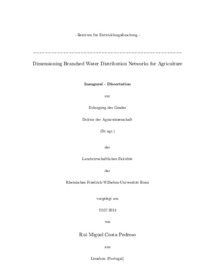Dimensioning Branched Water Distribution Networks for Agriculture

Dimensioning Branched Water Distribution Networks for Agriculture

| dc.contributor.advisor | Hiemenz, Ulrich | |
| dc.contributor.author | Costa Pedroso, Rui Miguel | |
| dc.date.accessioned | 2020-04-19T08:49:25Z | |
| dc.date.available | 2020-04-19T08:49:25Z | |
| dc.date.issued | 26.05.2014 | |
| dc.identifier.uri | https://hdl.handle.net/20.500.11811/5840 | |
| dc.description.abstract | The implementation of water distribution networks for irrigation represents an important investment for the development of many countries and for food security. These investments are mostly executed based solely on engineering designs, resting on the minimization of the network’s costs, without regard to the balance between the life-cycle irrigation benefits, lifecycle costs of the investment and the hydraulic conditions. Such designs and investments can, in the long-term, incur unsustainable operation and maintenance costs as well as poor cost recovery. The imperative motivation of this work was the necessity for bridging engineering, agricultural and economic reasoning in dimensioning water distribution networks, i.e. the necessity for inclusive life-cycle cost-benefit optimization approaches, for the simultaneous dimensioning of the network and the appraisal of the investment. For this purpose, a cost-benefit framework for project appraisal was developed as an optimization model that delivers the net-present value of the investment and optimal design of the network for selected rates of return, i.e. size of the network (or number of hydrants in the optimal solution), pipeline diameters, pump system capacity (discharges, heads and power demanded per irrigation shift), as well as the optimal spatial distribution of simultaneous operating hydrants per irrigation shift. The natural mathematical formulation of the problem is of the mixed integer non-linear type. In this work, a linear approximation with a mixed integer formulation was developed, based on piece-wise linear approximations of the non-linear hydraulic constraints and non-linear energy costs in the objective function of the model. The efficient approximations and modern solvers allowed the model results to be achieved in short computation times. The model was applied to a case-study in Upper-Egypt, an agricultural settlement and irrigation water distribution network project included in Egypt’s program for desert land reclamation. The model produces optimal network designs according to the project returns expected by the implementation agency, as well as expectation on diesel and food price (benefits) developments. The results in the different scenarios showed that more irrigation hydrants (and agricultural area) will only be included in the optimal solution, if their marginal bene.t contribution to the objective function is at least as large as their marginal costs. In this process, the model accounts for the different elevations of hydrants, i.e. the benefits inherent to each hydrant are equated to the hydrant’s cost of connection and operation at the different elevations and distances to the pump system (head losses). This is a major result for implementing agencies which need to decide on the best network size, given topographical characteristics. The model is also able to optimally determine the shift pattern simultaneously with the size of the network. It derives a shift pattern that best balances the trade-offs between energy and initial investment costs for the given scenario and the project’s demanded level of return. Including cost recovery concerns showed a strong economic non-sustainability for the case-study. Charging farmers only for energy costs would result in very low net-returns to a family’s land, work and management, and would probably not allow family subsistence. The model has proved to be a major tool for project appraisal, allowing a full economic estimation of the social costs and benefits involved in the implementation of water distribution networks for irrigation. The agency can compare projects in different locations, or decide between implementing larger or smaller irrigation settlements. Decision criterion can be based on the project’s rates of return and also complemented with other development objectives like employment. These complementary objectives can be used to help decide between projects with equal rates of return. The present work shows that investments in water distribution networks for irrigation can and should be made using much more comprehensive engineering, agricultural and economic methods. | en |
| dc.language.iso | eng | |
| dc.rights | In Copyright | |
| dc.rights.uri | http://rightsstatements.org/vocab/InC/1.0/ | |
| dc.subject | Wasserverteilungsnetze | |
| dc.subject | Bewässerung | |
| dc.subject | Optimierung | |
| dc.subject | Kosten-Nutzen-Analyse | |
| dc.subject | Water distribution Networks | |
| dc.subject | Irrigation | |
| dc.subject | Optimization | |
| dc.subject | Cost Benefit Analysis | |
| dc.subject.ddc | 630 Landwirtschaft, Veterinärmedizin | |
| dc.title | Dimensioning Branched Water Distribution Networks for Agriculture | |
| dc.type | Dissertation oder Habilitation | |
| dc.publisher.name | Universitäts- und Landesbibliothek Bonn | |
| dc.publisher.location | Bonn | |
| dc.rights.accessRights | openAccess | |
| dc.identifier.urn | https://nbn-resolving.org/urn:nbn:de:hbz:5n-35803 | |
| ulbbn.pubtype | Erstveröffentlichung | |
| ulbbn.birthname | Pedroso | |
| ulbbnediss.affiliation.name | Rheinische Friedrich-Wilhelms-Universität Bonn | |
| ulbbnediss.affiliation.location | Bonn | |
| ulbbnediss.thesis.level | Dissertation | |
| ulbbnediss.dissID | 3580 | |
| ulbbnediss.date.accepted | 02.12.2013 | |
| ulbbnediss.institute | Zentrale wissenschaftliche Einrichtungen : Zentrum für Entwicklungsforschung (ZEF) | |
| ulbbnediss.fakultaet | Landwirtschaftliche Fakultät | |
| dc.contributor.coReferee | Bogardi, Janos J. |
Files in this item
This item appears in the following Collection(s)
-
E-Dissertationen (1035)




